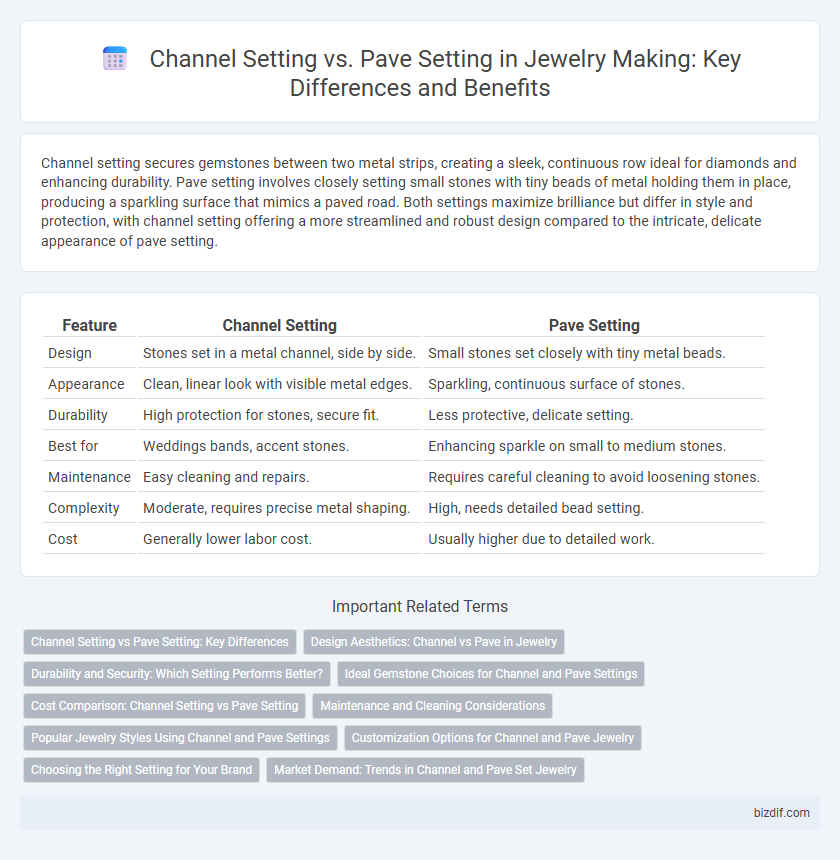Channel setting secures gemstones between two metal strips, creating a sleek, continuous row ideal for diamonds and enhancing durability. Pave setting involves closely setting small stones with tiny beads of metal holding them in place, producing a sparkling surface that mimics a paved road. Both settings maximize brilliance but differ in style and protection, with channel setting offering a more streamlined and robust design compared to the intricate, delicate appearance of pave setting.
Table of Comparison
| Feature | Channel Setting | Pave Setting |
|---|---|---|
| Design | Stones set in a metal channel, side by side. | Small stones set closely with tiny metal beads. |
| Appearance | Clean, linear look with visible metal edges. | Sparkling, continuous surface of stones. |
| Durability | High protection for stones, secure fit. | Less protective, delicate setting. |
| Best for | Weddings bands, accent stones. | Enhancing sparkle on small to medium stones. |
| Maintenance | Easy cleaning and repairs. | Requires careful cleaning to avoid loosening stones. |
| Complexity | Moderate, requires precise metal shaping. | High, needs detailed bead setting. |
| Cost | Generally lower labor cost. | Usually higher due to detailed work. |
Channel Setting vs Pave Setting: Key Differences
Channel setting features gemstones secured between two parallel metal strips, creating a sleek, continuous row ideal for durability and protection. Pave setting involves closely set small stones held by tiny prongs or beads, maximizing sparkle with minimal metal visibility. Key differences include channel setting's enhanced stone protection versus pave setting's emphasis on brilliance and intricate design detail.
Design Aesthetics: Channel vs Pave in Jewelry
Channel setting offers a sleek and modern design aesthetic by securely embedding gemstones between two metal walls, creating a continuous, uninterrupted sparkle line often seen in wedding bands and tennis bracelets. Pave setting enhances jewelry with a dazzling, intricate surface of closely set tiny diamonds or gemstones, giving a glittering, textured effect that maximizes brilliance and light reflection. The choice between channel and pave setting significantly influences the piece's visual impact, where channel setting emphasizes clean lines and durability, while pave setting delivers ornate elegance and maximum sparkle.
Durability and Security: Which Setting Performs Better?
Channel setting offers superior durability and security by encasing gemstones between two metal strips, protecting edges from impacts and reducing the risk of stones loosening over time. Pave setting involves closely set smaller stones held by tiny beads or prongs, which can be more vulnerable to wear and require more maintenance to ensure stability. For high-traffic jewelry pieces like rings, channel setting generally performs better in maintaining gemstone integrity and minimizing stone loss.
Ideal Gemstone Choices for Channel and Pave Settings
Ideal gemstones for channel settings include diamonds, sapphires, and emeralds due to their hardness and durability, which securely fit between metal strips without the risk of chipping. Pave settings are best suited for smaller, uniformly cut stones like round brilliant diamonds and white sapphires that create a continuous surface of sparkle with minimal metal visibility. Both settings emphasize stones that can withstand close setting without damage, ensuring longevity and brilliance in fine jewelry designs.
Cost Comparison: Channel Setting vs Pave Setting
Channel setting generally costs more than pave setting due to the complexity of creating grooves to securely hold gemstones, which requires precision and additional labor. Pave setting involves placing small stones closely together with minimal metal, making it less labor-intensive and more cost-effective for small diamonds or crystals. The choice between channel and pave setting impacts overall jewelry cost depending on stone size, metal type, and craftsmanship required.
Maintenance and Cleaning Considerations
Channel settings feature stones secured between metal walls, reducing the accumulation of dirt and requiring less frequent cleaning compared to pave settings, which have multiple small stones held by tiny prongs that can trap debris more easily. Pave settings demand careful maintenance to ensure prongs remain intact and stones are secure, with regular inspections recommended to prevent loss. Ultrasonic cleaning is generally safe for channel settings but should be used cautiously with pave settings to avoid loosening delicate stones.
Popular Jewelry Styles Using Channel and Pave Settings
Channel setting is favored in classic and engagement rings for securely holding gemstones in a sleek metal groove, enhancing durability and a clean look. Pave setting is popular in luxury and cocktail rings, featuring numerous small diamonds closely set to create a continuous sparkling surface. Both settings are prominent in contemporary fashion jewelry, emphasizing brilliance and elegance in pieces like wedding bands and statement rings.
Customization Options for Channel and Pave Jewelry
Channel setting offers precise customization with metal walls securely holding stones in place, ideal for designs featuring rows of gemstones with a sleek, modern look. Pave setting provides flexible customization by closely setting numerous small stones with minimal metal visibility, creating a continuous sparkle effect ideal for intricate, detailed jewelry designs. Both settings allow artisans to tailor gemstone size, shape, and arrangement to match unique style preferences and design complexity.
Choosing the Right Setting for Your Brand
Channel setting offers a sleek, modern look with stones set flush between metal walls, providing durability and protection ideal for active lifestyles. Pave setting creates a continuous sparkle by closely setting small stones with minimal metal visibility, enhancing brilliance for luxury-focused designs. Selecting the right setting depends on your brand's style identity and target audience, balancing durability with visual impact.
Market Demand: Trends in Channel and Pave Set Jewelry
Channel setting remains highly sought after for its sleek, durable design that securely holds gemstones between metal walls, making it especially popular in engagement rings and wedding bands. Pave setting attracts consumers favoring intricate sparkle and a luxurious, vintage appeal with tiny stones set closely together, driving strong demand in fashion and statement jewelry. Current market trends indicate rising interest in pave settings for custom, high-glamour pieces, while channel setting dominates segments prioritizing durability and everyday wear.
Channel setting vs Pave setting Infographic

 bizdif.com
bizdif.com